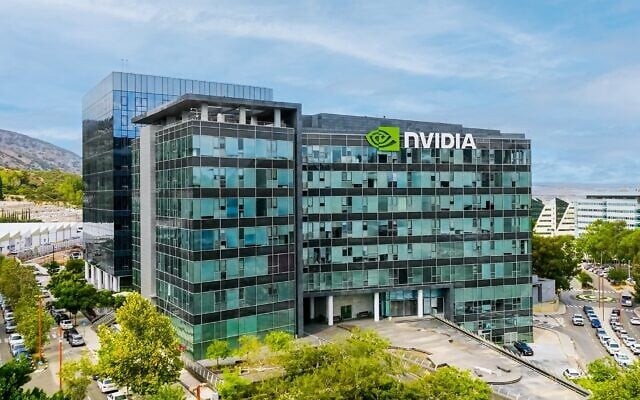Published on: Oct 26, 2025 07:47 pm IST
Blog
-

US chipmaker Nvidia scouts for Israeli AI talent, in expansion of R&D hub in south
US chipmaker Nvidia on Sunday announced plans to triple the size of its research and development presence in Beersheba, a city in the country’s south, and hire hundreds of additional Israeli staff.
The chip giant will move its current Beersheba R&D center to a newly built, nearby site, three times the size of its existing 1,000-square-meter facility. The new site, located at Beersheba’s Gav Yam high-tech park, covers about 3,000 sqm and is expected to be fully operational by the end of the first half of 2026.
As part of the expansion, Nvidia is seeking to hire hundreds of additional employees in the southern region, including chip developers, hardware and software engineers, architects, students, and university graduates.
Nvidia senior vice president Amit Krig said that the firm’s expansion in Beersheba reflects the chipmaker’s commitment to hunting for the “best engineers — wherever they are.”
“The new site will serve as a professional home for hundreds of additional developers from Beersheba and the surrounding area, who will be part of creating groundbreaking hardware and software technologies and advancing global innovation in artificial intelligence,” said Krig, who heads Nvidia’s R&D operations in Israel.
Nvidia’s R&D activities in Israel are already the firm’s largest outside of the US. The computing giant, valued at more than $4.5 trillion on Wall Street, is one of the country’s largest employers with over 5,000 workers in Israel in seven R&D centers, from Yokne’am in the north through Tel Aviv, Jerusalem, and Ra’anana in the center of the country to Beersheba in the south.
Illustration of Nvidia’s new R&D center located in the southern city of Beersheba. (Courtesy of Moshe Tzur Architects) Many of Nvidia’s high-end processors and networking chips, essential for training the largest AI models, are developed at its R&D centers in Israel. As global tech firms including Microsoft, Amazon, Alphabet, and Tesla race to build AI data centers and dominate the emerging technology, demand for Nvidia’s most advanced processors is surging.
“The establishment of Nvidia’s new site tripling its operations in the city is important news for Beersheba and the Negev,” said Beersheba Mayor Ruvik Danilovich. “The decision expresses confidence in Beersheba’s ecosystem, and will create hundreds of new jobs that will strengthen the city’s human capital and cement its position as a leading innovation center.”

US chipmaker Nvidia’s offices in Yokne’am in Israel’s north. (Courtesy) In recent years, Beersheba’s Gav Yam high-tech center, adjacent to Ben-Gurion University of the Negev, has grown into a thriving hub of R&D facilities for leading tech companies, including Microsoft, Dell, Wix, and defense contractors Rafael Advanced Defense Systems and Elbit Systems.
Nvidia’s expansion in the south comes after the chipmaker announced a plan in July to build a massive multibillion-dollar tech campus in Israel’s north, which is expected to provide thousands of jobs. The computing juggernaut is seeking a plot of land spanning 70 to 120 dunams (30 acres) with construction rights to build a campus of 80,000–180,000 sqm in the area of Zichron Yaakov, Haifa, or the Jezreel Valley.
Alongside its R&D operations, Nvidia has made a number of mega acquisitions deals in Israel over the past decade. In December 2024, the chipmaker completed the purchase of Israeli AI workload management startup Run:ai for an estimated $700 million. It marked Nvidia’s largest acquisition in the country since buying Israel’s Mellanox Technologies Ltd., a maker of high-speed servers and storage switching solutions used in supercomputers globally, for a massive $7 billion in 2020.
Continue Reading
-

A Closer Look at Qualys (QLYS) Valuation Following Recent Share Price Trends
Qualys (QLYS) shares are trending slightly higher so far this month, showing around a 1% positive return over the past week. This comes at a time when the broader technology sector continues to face market volatility. Investors are keeping an eye on valuation and trends after recent pullbacks.
See our latest analysis for Qualys.
Zooming out, Qualys’s share price has slipped nearly 8% year-to-date but still posts a positive 1-year total shareholder return of around 6%. This reflects a mix of investor caution and enduring belief in its growth story. The momentum has faded recently, although its longer-term track record highlights an ability to deliver for shareholders.
Curious what else savvy investors are discovering? This could be a perfect time to broaden your research with fast growing stocks with high insider ownership
With Qualys trading below its analyst price target and fundamentals showing steady growth, the key question now is whether the stock is undervalued and offering potential upside, or if the market has already priced in future gains.
The current narrative fair value for Qualys lands at $141, which is noticeably higher than its last closing price of $128.05. This gap highlights ongoing optimism about the company’s prospects and sets the foundation for the key thinking driving this estimate.
Adoption of Qualys’ new cloud-native risk operations center (ROC) and Agentic AI platform positions the company as a leading pre-breach risk management provider. It offers unified orchestration, automation, and remediation across both Qualys and non-Qualys data. This opens incremental greenfield opportunities and should support higher ARPU and expanded TAM, leading to durable revenue and earnings growth.
Read the complete narrative.
What exactly propels this bullish narrative? Behind the ambitious price target are bold expectations about rising average customer spend, new platform launches and growing demand from global organizations. Want to see how much future growth, profit expansion and technology innovation must deliver in reality to make these numbers stack up? Find out what the consensus is betting on and what needs to go right by reading the full breakdown.
Result: Fair Value of $141 (UNDERVALUED)
Have a read of the narrative in full and understand what’s behind the forecasts.
However, rapid AI innovation and new pricing models could disrupt Qualys’s momentum if competitors advance more quickly in development or if customer adoption trends unexpectedly shift.
Find out about the key risks to this Qualys narrative.
Continue Reading
-

Outsmarting disease: Why snakes and other reptiles pee crystals
Every species has tricks that make survival possible. Reptiles, for example, handle waste like no other group. Instead of releasing liquid urine, they excrete solid white crystals. It’s not just strange – it’s smart. These crystals save…
Continue Reading
-

Fresh Institutional Moves Spark Interest in Valuation After Reinsurance and Catastrophe Risk Updates
Palomar Holdings (PLMR) has been in the spotlight following a recent mix of cautious and optimistic signals from institutional investors. Changes in hedge fund positions, along with the completion of key reinsurance programs, have prompted renewed market attention.
See our latest analysis for Palomar Holdings.
After navigating a stretch of cautious sentiment related to reinsurance renewals and hurricane season risks, Palomar Holdings is showing more stable momentum. Its latest share price sits at $113.25, and while the short-term returns have been muted, the 1-year total shareholder return of 23.5% highlights growing long-term optimism despite recent volatility.
If you’re curious about what other companies are attracting institutional attention, now is a perfect moment to broaden your search and discover fast growing stocks with high insider ownership
With the stock trading below analyst price targets and showing solid revenue and income growth, the question remains: Is Palomar Holdings undervalued at current levels, or are investors already pricing in future momentum?
With Palomar Holdings closing at $113.25 versus the most popular narrative fair value of $153.33, the case for upside is compelling and getting attention as analyst expectations shift.
Ongoing investment in proprietary technology, data analytics, and advanced underwriting disciplines is improving risk assessment and pricing accuracy, already reflected in strong combined ratios and low loss ratios. This should continue to enhance underwriting profitability and expand net margins over time.
Read the complete narrative.
Curious about what’s behind this bullish fair value? The narrative hangs on rapid growth projections. One key assumption could be surprisingly aggressive. There’s a crucial forward valuation embedded here that you may not expect for an insurer. Dig in to discover the foundational numbers and the future profit model that could shake up price targets.
Result: Fair Value of $153.33 (UNDERVALUED)
Have a read of the narrative in full and understand what’s behind the forecasts.
However, intensifying competition and Palomar’s reliance on catastrophe-exposed property lines could quickly shift profitability and challenge the current growth narrative.
Find out about the key risks to this Palomar Holdings narrative.
While the market’s favorite narrative points to a bargain, looking at the company’s price-to-earnings ratio offers a more cautious perspective. Palomar trades at 19.6 times earnings, which is notably higher than the US Insurance industry average of 13.5 times and a peer average of 13.8 times. The fair ratio, which is what the market could eventually gravitate toward, is just 16.2 times. This substantial gap suggests that Palomar’s shares could be at risk of a pullback if expectations shift. Could these elevated multiples limit future upside?
Continue Reading
-

The Toyota Supra Officially Dies Early Next Year
Toyota has announced it will end Supra production next March, with 2026 being the car’s last model year. The automaker already introduced the Final Edition, which…
Continue Reading
-

Will Rising Self-Mined Bitcoin Output and AI Demand Shift Bitdeer Technologies Group’s (BTDR) Long-Term Narrative?
-
Bitdeer Technologies Group recently announced unaudited operating results for September 2025, reporting that it mined 452 Bitcoins, a rise of approximately 20.5% from August, driven by increased self-mining capacity following the energization of SEALMINERs.
-
This operating update comes as sector optimism grows, with attention on data center demand and AI-driven computing partnerships possibly benefiting industry players like Bitdeer.
-
With Bitdeer’s self-mining gains and momentum in high-performance computing demand, we’ll assess how these developments affect the company’s broader investment narrative.
AI is about to change healthcare. These 33 stocks are working on everything from early diagnostics to drug discovery. The best part – they are all under $10b in market cap – there’s still time to get in early.
To be a shareholder in Bitdeer Technologies Group, one needs to believe in the company’s ability to scale its self-mining capacity and commercialize its proprietary ASIC technology amid rising demand for high-performance computing. The recent news of a 20.5% increase in Bitcoin mined boosts short-term confidence, but it does not materially change the core catalyst, growing revenue and margins from ASIC commercialization, nor does it reduce the key risk of persistent losses and high operating expenses.
The September operating update most directly ties to the recent launch of the SEALMINER A3 series, which underpins Bitdeer’s growth in self-mining hashrate and supports the narrative around technological advancement improving capital efficiency. As Bitdeer pushes further into ASIC development and ramp-up, this connection highlights how delivering on technical improvements remains intertwined with realizing forecast revenue growth and addressing margin pressures.
However, despite these production gains, investors should not overlook the risk stemming from high operating expenses and ongoing losses, especially if future ASIC sales do not keep pace with growing costs…
Read the full narrative on Bitdeer Technologies Group (it’s free!)
Bitdeer Technologies Group’s narrative projects $1.8 billion revenue and $343.9 million earnings by 2028. This requires 71.6% yearly revenue growth and a $664.2 million increase in earnings from the current -$320.3 million.
Uncover how Bitdeer Technologies Group’s forecasts yield a $28.05 fair value, a 21% upside to its current price.
BTDR Community Fair Values as at Oct 2025 Seven individual fair value estimates from the Simply Wall St Community for Bitdeer span US$18.55 to US$324.62, highlighting a broad spectrum of conviction. With high expenses a persistent concern, you can explore how fellow investors weigh these risks before forming your outlook.
Continue Reading
-
-

Gauging Valuation After Recent Modest Gains in Autonomous Vehicle Tech
Aurora Innovation (AUR) shares have edged slightly higher recently, following a modest uptick of about 2% in the last day and smaller gains over the past week. Investors seem to be weighing the company’s performance during the month, as Aurora continues its work in autonomous vehicle technology.
See our latest analysis for Aurora Innovation.
Zooming out, Aurora Innovation’s 1-year share price return is still down double digits, while its three-year total shareholder return remains notably positive. After a recent stretch of modest gains, momentum is still searching for its footing as investors gauge the company’s long-term roadmap and evolving risk profile.
If Aurora’s recent moves have you reflecting on shifts across the sector, now is the perfect time to explore innovation on a broader scale through the See the full list for free.
With shares trading well below analyst price targets and impressive long-term gains in the rearview, investors now face a critical question: Is Aurora a bargain poised for growth, or is the market already factoring in its future potential?
At a price-to-book ratio of 4.8x, Aurora Innovation trades below its peer average of 5.9x based on this valuation measure. This suggests the stock is relatively more attractively priced compared to similar companies. With the last close at $5.15, this indicates the market is discounting Aurora relative to its book value more than its immediate peer group.
The price-to-book ratio compares a company’s market value to its net asset value. This metric is particularly relevant for asset-light and high-growth sectors like software and autonomous vehicles. For Aurora, this ratio reflects what investors are willing to pay for the company’s equity compared to the book value recorded on its balance sheet.
This valuation suggests investors may be skeptical about Aurora’s path to profitability or are discounting near-term challenges, despite the sector’s broader appetite for growth. However, the company’s price-to-book still remains higher than the US Software industry average of 4x. This signals the market may still be assigning a premium for its technology or future prospects relative to the average US software company, though less so compared to its closest peers.
See what the numbers say about this price — find out in our valuation breakdown.
Result: Price-to-Book of 4.8x (UNDERVALUED compared to peers)
However, continued net losses and uncertainty around the company’s path to profitability remain challenges that could weigh on future share performance.
Continue Reading
-

Integrating GLP-1 Therapy, Advancing CSU Care, and Expanding Access
GLP-1 Receptor Agonists and Psoriasis
According to Serota, dermatologists should recognize obesity as a chronic inflammatory condition that often exacerbates inflammatory skin diseases such as psoriasis. “If your patient is overweight or obese,…
Continue Reading
-

World’s First Private Space Station, Haven-1 sets world record
Long Beach, California, United State–Haven-1, developed by the American company
Vast, a single-module station designed to launch in May 2026 on a SpaceX Falcon 9 rocket and will support up to four astronauts for short-duration missions,…Continue Reading


